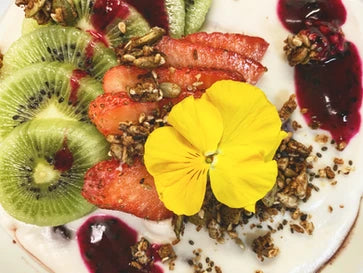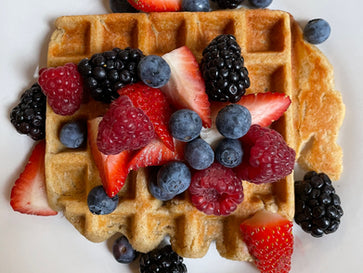It’s Women’s History Month, and that means we are talking about nutrition for our ladies! We’re touching on some incredibly accessible diet and exercise recommendations to help you live your strongest life. Let’s age gracefully together by taking care of ourselves for the present and preparing our bodies for the future. Simple lifestyle changes can make huge, long-lasting differences in your mind and body which will reflect on the people around you.
Breast Health
There’s not a certain appointed time in a woman’s life when they should start to care about breast health. Screening for breast cancer is strongly encouraged starting at around age 40+ (or when your doctor recommends). Women can also schedule a genetic test to check for BRCA genes (breast cancer genes). But, having a mammography or genetic testing isn’t complete prevention. Did you know that only 5 to 10 percent of all breast cancer comes from an inherited gene mutation? If the BRCA genes are mutated or broken, they can be passed down from one generation to the next. That being said, 90-95% of breast cancer cases are engendered by diet and lifestyle choices, not by a genetic predisposition. 87% of women with breast cancer actually have NO first-degree relatives with breast cancer. We’ve all been taught that if there is a history of breast cancer in the family, we might have a good chance of being diagnosed ourselves someday. The data shows that any consistencies within a family are most likely due to the fact that those family members are probably eating similar diets and have similar lifestyles. If you grew up in a house where an excess of meat, dairy, highly processed foods, and alcohol was prominent, you may be at risk if you carry the same habits with you throughout your life. The cycle of the familial manner in which we approach food can of course be broken.
Eat for Breast Health
-
Soy - not to be feared, the phytoestrogens in soy work as blockers against the “bad for you” estrogen from entering your system. Soy estrogens decrease the estrogen response as true estrogens help to trigger breast cancer.
-
Flax Seeds - Contains lignans which have been known to show a reduction of growth in hormone-sensitive cancer tumors such as the prostate, breast, and endometrium. They are also a fantastic source of fiber.
-
Leafy Greens and Cruciferous Vegetables - Extensively investigated, isothiocyanate, a sulforaphane found in cruciferous vegetables is known for its health benefits and may help to protect against cancer.
-
Berries and Pomegranate - Ellagic acid, an organic compound found in these types of fruit have been known to have strong antioxidant and antiproliferative effects.
-
Apples - Don’t skimp on the peels! That’s where the powerful antioxidants and roughage are. Studies have shown that extracts from the peel killed cancer cells in a petri dish, but not in the pulp.
-
Mushrooms - The simple white button mushroom actually has powerful flavones which are said to suppress inflammation and are immune-modulating.
-
Alliums (onions, garlic, shallots, leeks) - Functional components in alliums are known for their anti-tumor properties and insulin resistance with breast cancer in chemotherapy. It’s important to mix some raw alliums into your dishes.
Try our hand-scooped Organic Thai Young Coconut Yogurt with fruit puree, fresh fruits, and nut/seed granola for breakfast.
And…
our Organic Caesar Salad with kale, organic caesar dressing, organic maple BBQ marinated tempeh, and pickled onions for lunch.


Bone Health
Similarly to breast health, one should also think of “food as medicine” for bone health. In addition to a whole foods/plant-based diet, vitamin D, calcium, and exercise are considered the holy trinity for strong bones. But, why do we think we need milk and other dairy products to develop strong bones? Well, it’s been embedded into our society since we were children. Milk in school, the Got Milk? Campaign, being told we won’t grow up big and strong without it. However, a study showed that American women, aged 50+ had one of the highest rates of hip fractures in the world. The other countries that showed even higher rates also had higher milk consumption than the U.S. Those countries were Australia, New Zealand, and countries within Europe. Hip fractures can be indicators of osteoporosis, a bone disease that tends to target women post-menopause. Countries with the highest milk consumption also have the highest rates of osteoporosis. These same countries also have the lowest vitamin D status. A peer-reviewed Yale study involving subjects who were women and 50+ in age found that 70% of fracture rates were connected to the consumption of animal protein. The reason being that animal protein creates an acidic overload, which is eventually fought off by the body by using calcium from our bones. This loss of calcium weakens the bones and puts them at greater risk of fracture. Animal protein can also suppress the production of vitamin D, along with excessive calcium, unlike plant proteins.
Eat for Bone Health
-
Cruciferous Vegetables including broccoli, kale, bok choy, collard greens, mustard greens, turnip greens, watercress - These are amazing sources of calcium and also contain sulforaphane, which may decrease the risk of osteoporosis.
-
Flax Seeds - A rich, plant-based source of ALA, a plant-derived omega-3 fatty acid known to reduce osteoporosis.
-
Mushrooms - Incredibly high in vitamin D, mushrooms are bone health superfoods - especially the portobello, maitake, morel, button, and shiitake varieties.
-
Calcium-Set Tofu - Even if not calcium-set, tofu is a great source of vitamin D.
-
Fortified Plant Milk
Get Moving!
Cardiovascular exercises are incredibly important but they don’t “load the bone.” as Simon Hill, MSc, BSc states. You will want to work on impact exercises such as jumping rope, burpees, jogging, squat jumps, or stair climbing. Resistance training such as squats, lunges, resistance bands, push-ups, and planks are also very important. Yoga is highly recommended for strength building through controlled resistance.
Try our Organic Protein Packed Almond Butter Muffin for breakfast.
And…
our Organic Burmese Chickpea Curry with forbidden rice, lacinato kale, and Burmese fried onions for lunch.



Skin, Hair, and Nails
Eat your way to beautiful skin, hair, and nails. Fruits, vegetables, whole grains, beans, and legumes are necessary for a nutrient-dense diet. Have you ever heard someone say that ditching dairy cleared up their skin? This can absolutely happen through a plant-based diet. Eating the rainbow and including plenty of fibrous plants can create a healthy gut which shows on parts of us you would never expect. 97% of Americans are fiber deficient which makes sense considering only about 3% of Americans are currently vegan. Fiber helps to also increase the absorption of antioxidants and nutrients. Fruits and vegetables contain the essential vitamins, amino acids, antioxidants, and phytonutrients that help us glow from the inside out. Eating your water also helps to promote healthy skin by hydrating and providing nutrients in concert with one another. It’s important to incorporate plant diversity into your diet not only for a healthy gut microbiome, but to bring in plants that are magnesium, zinc, calcium, potassium, iron, and silica-rich.
Just a Few Foods for BEAUTY
-
Spinach
-
Dandelion Greens
-
Cucumbers
-
Collards
-
Bell Peppers
-
Sweet Potatoes
-
Quinoa
-
Lentils
-
Bananas
-
Apples
-
Walnuts
-
Pumpkin Seeds
-
Tomatoes
-
Avocado
-
Sea Vegetables
Try our Organic Amaranth Porridge with fresh fruit, maple pecans, and hand-scooped coconut yogurt drizzle for breakfast.
And…
our Organic Mohinga Noodle Soup with anti-inflammatory properties, containing sweet potatoes, ginger, turmeric, lemongrass, and more for lunch.


https://www.cdc.gov/genomics/disease/breast_ovarian_cancer/breast_cancer.htm
https://pubmed.ncbi.nlm.nih.gov/11705483/
https://pinklotus.com/powerup/
The China Study by: T. Colin Campbell, PhD and Thomas M. Campbell II
How Not to Die by: Michael Gregor, M.D., FACLM
https://pubmed.ncbi.nlm.nih.gov/31754945/
https://pubmed.ncbi.nlm.nih.gov/30372361/
https://pubchem.ncbi.nlm.nih.gov/compound/Ellagic-acid
https://pubmed.ncbi.nlm.nih.gov/20432173/
Liu, R.Journal of Agricultural and Food Chemistry, March 23, 2005; vol 53. News release, Cornell University.
https://www.ncbi.nlm.nih.gov/pmc/articles/PMC7321129/
https://www.ncbi.nlm.nih.gov/pmc/articles/PMC5316450/
The Royal Society of Chemistry 2017, Issue 32, 2017





Leave a comment
This site is protected by hCaptcha and the hCaptcha Privacy Policy and Terms of Service apply.